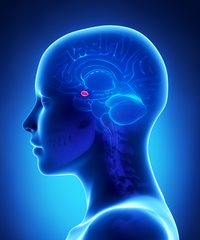October 10, 2016 Print
A team of Australian and United States mental health researchers has found that combining new brain scan techniques with patient information about any early life trauma can predict with unprecedentedly high (80%) accuracy whether a depressed patient is likely to recover with anti-depressant medications (ADM), or not.
The ability to predict ADM response is important because, up until now, the prescription by doctors of one kind of ADM over another has been largely guesswork and finding the right drug treatment can take years.
The research, published in the journal Proceedings of the National Academies of Science (PNAS), was led by a team at
Stanford University, headed by Professor Leanne Williams.
The PNAS findings were based on data from 80 patients collected by The Westmead Institute for Medical Research in
 Image showing the amygdala in the brain
Image showing the amygdala in the brain
Sydney as part of the International Study to Predict Optimized Treatment in Depression (iSPOT-D), funded by Brain Resource Pty Ltd.
Paper co-author and director of The Westmead Institute’s Brain Dynamics Centre, Dr Mayuresh Korgaonkar, worked with Professor Williams on the MRI data collection for iSPOT-D.
Study participants lay in a functional MRI machine while viewing images of happy faces and fearful faces on a screen in front of them. Each face triggered brain circuits involving the amygdala – the main area of the brain responsible for evaluating and generating emotions.
“We know from previous research that the relative reactivity of the amygdala is strongly associated with depression,” said Dr Korgaonkar.
“In simple terms, if your amygdala is impaired you are more vulnerable to suffer from depression.
“We also know that high levels of exposure to early life stress (ELS) can impact on the amygdala, physically damaging the area - and its ability to moderate emotional response.”
The MRI scans were conducted both before and after an eight-week treatment period with three commonly used antidepressants: sertraline (Zoloft), escitalopram (Lexapro) and venlafaxine (Effexor).
Participants also completed a 19-item questionnaire on ELS, which assessed exposure to abuse, neglect, family conflict, illness or death (or both), and natural disasters prior to the age of 18.
The researchers analysed the pre-treatment imaging and the questionnaire to predict how the individual patients would respond immediately after the eighth week.
Using a statistical analysis called predictive modelling, study results showed that participants exposed to a high level of ELS were most likely to recover with antidepressants if the amygdala was reactive to the happy faces.
Those with a high level of ELS whose amygdala showed low reactivity to the happy faces were less likely to recover with antidepressants.
“We were able to show how we can use an understanding of the whole person — their experiences and their brain function and the interaction between the two — to help tailor treatment choices,” said Professor Williams.
“We can now predict who is likely to recover on antidepressants in a way that takes into account their life history.”
This research finding is an important step towards giving clinicians the first objective diagnostic tool for the treatment of depression.
The researchers envision the integrated clinic of the future in which physicians ask about childhood trauma and order a five-minute brain scan to help determine the best line of treatment.
“If we are thinking about trying to get this right the first time, it’s useful to consider the option of ordering a scan,” Professor Williams said. “It’s already done for so many other things - a broken leg, a heart problem, a potential tumour.”
The study also provides a table that the researchers say could ultimately be used by practicing physicians to determine the threshold at which antidepressant treatment is recommended depending on the varying levels of ELS and brain-scan results from patients.
Better depression diagnostics could make a significant impact of the community burden that results from the disease – and decrease the suffering of those affected.
“Today, if the first line of treatment doesn’t work, patients spend an average of two to three years going through a trial-and-error period before getting treatment that helps,” said Dr Korgaonkar.
“Quite aside from the patient’s continued suffering, the cost the economy of health care and lost productivity is enormous.”
“Better treatments for depression are urgently needed.”